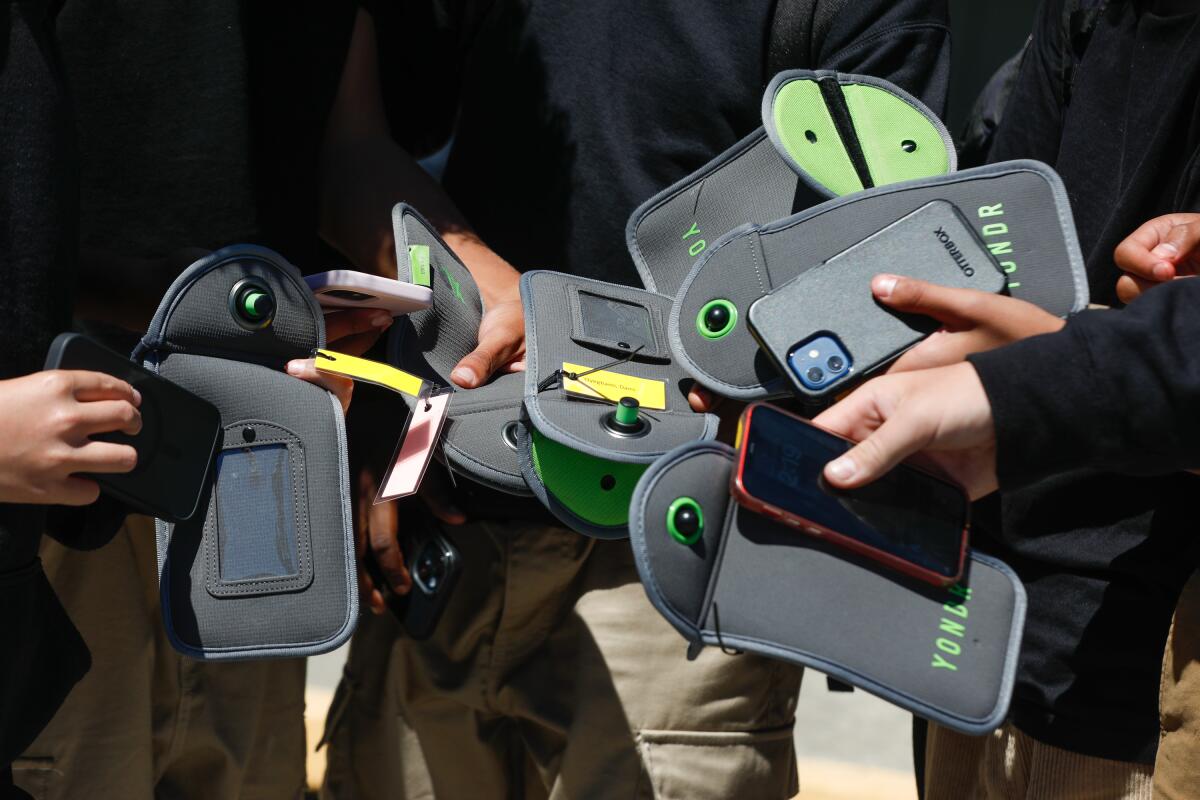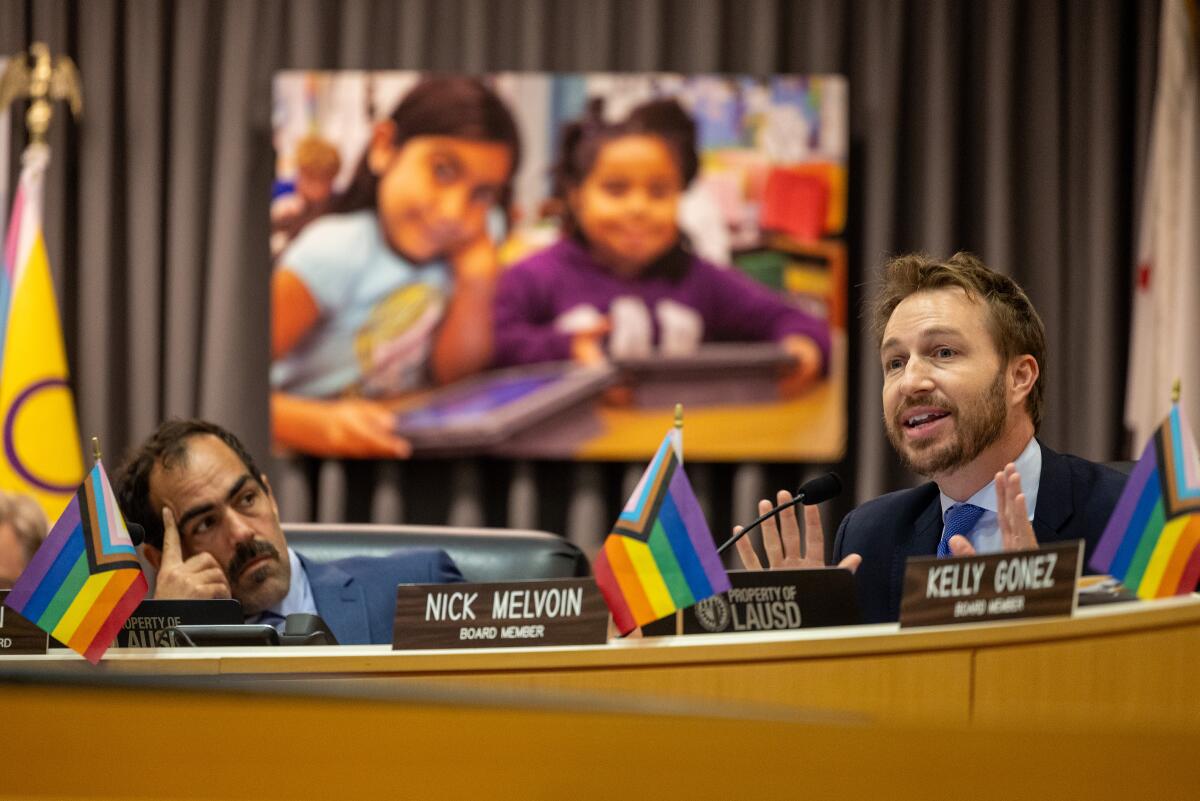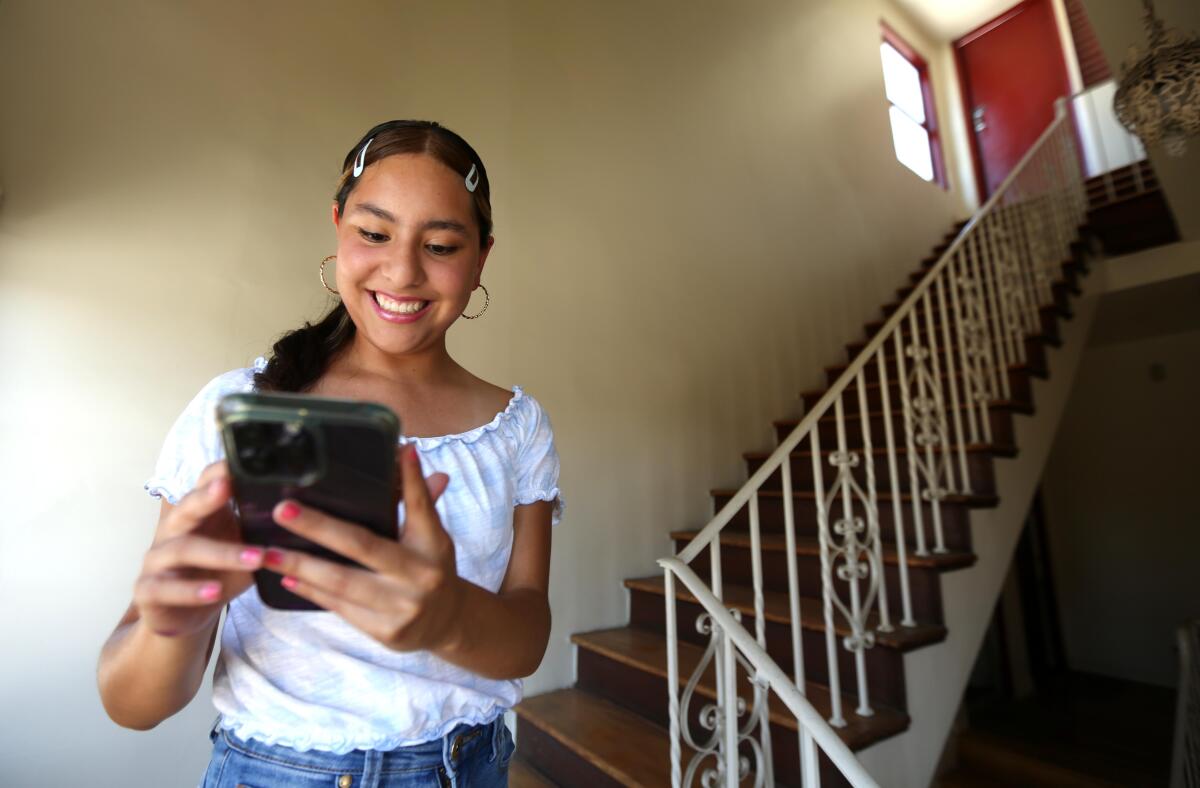‘Turned off and stored.’ LAUSD reveals details on school cellphone ban to begin Feb. 18

- Share via
Los Angeles Unified has offered the first details of what a cellphone-free school day will soon look like as educators attempt to break the digital-device obsession of a generation of students, aiming to get them off their screens and focused on classroom learning.
The cellphone ban in the nation’s second largest school district will take effect in mid-February, about a month later than originally announced, and will also apply to smart watches and any other device that can be used to send messages, receive calls or scroll the internet. Phones will not be allowed during lunch or breaks, and each campus will decide how the devices will be stored or locked up.
District leaders acknowledged that implementing the ban will be a sea change at middle and high schools, where most students carry phones.
“Parent and student buy-in is absolutely critical,” Andres Chait, chief of school operations, said Tuesday to the school board.
Supt. Alberto Carvalho said school leaders were “methodical, careful and all-encompassing” as they studied options on what to do with cellphones. It’s clear, he said, that students have become “addicted,” a problem that “needs to come to an end.”
The LAUSD policy, approved by the Board of Education in June, will be stricter and enforced earlier than a recently passed state law requires. The California Phone-Free Schools Act ordered the state’s 1,000 school districts, charter schools and county education offices to draft student cellphone policies by July 1, 2026 — and leaves it up to schools to decide whether to enforce outright bans or some level of restrictions to “support pupil learning and well-being.”
When does the L.A. ban go in place?
The district has directed schools to enforce the ban beginning Feb. 18, the day after Presidents Day weekend.
About 50 schools out of a total of 1,543 in the district already have cellphone bans, Chait said. Many of those campuses began their own policies before the districtwide rule came into play. More than 400 campuses in the district are elementary schools, at which the vast majority of students do not have cellphones.
What hours will the ban be in effect?
Students could use phones going to and from school, such as when on the bus.
But phones would be off limits once the opening bell rings, including lunch or nutrition and other breaks, until the end of the school day.

How will schools restrict phones?
For weeks, teachers, principals, staff and parents at schools met to provide input on the ban, Chait said. High school students also participated.
Individual schools are being given several choices for how to keep students off their phones.
- The first and cheapest would require phones to stay in backpacks during the school day.
- Locked storage units — either in classrooms or schoolwide — could house multiple phones.
- Specialized pouches that can be opened only with magnets or closed with Velcro. Students would carry their phones in the sealed pouches all day.
- A “classroom phone holder” that could hang on a wall and have numbered pockets where phones are placed before class begins.
For the magnetic pouches, the best-known company that makes them is Yondr. Its products are already in use in a handful of L.A. Unified schools and many concert facilities. For the Velcro-sealing bags, Chait cited the brand Faraday, which sells pouches that block cellular and WiFi signals. He said every option has “pros and cons.”
“The minimal expectation is that the device is turned off and stored,” Chait said. Phones cannot be on silent or vibration settings, he said.
Schools must decide on their storage method before winter break in December.
Are only phones banned?
No. The ban also applies to smart watches and other devices that can use WiFi or cellular signals to send text messages or access social media. The Tuesday presentation also included ear buds — which typically connect to smartphones — and “smart glasses” as banned items.
“Other cellular devices that do not have ‘smart’ capability must be turned off and stored for the entire instruction day (e.g., devices that can only send/receive phone calls and text messages),” the presentation documents said.
“The intent here is to limit the distraction,” Chait said.

What about emergencies?
School board members raised questions about emergencies, as well as discipline for violations. The new state law requires students to have phone access during emergencies.
Citing online surveys conducted in his district, board member Scott Schmerelson said emergencies were a top issue.
“Parents are very focused on reaching their students in the event of an emergency,” Schmerelson said.
Rocio Rivas also asked Chait, “What constitutes an emergency?”
Basically, Chait said, it will be up to each school to decide.
In general, he said, students could only access phones during an emergency when “staff determines its safe to do so.”
Giving examples, Chait said a school lockdown by itself would not be a big enough emergency to allow students to access phones because such actions can be short — sometimes 10 minutes — and are often taken as a safety precaution in response to issues taking place off-campus.
But if a lockdown was an hour or longer, Chait said, “that would be a situation where we would tell our folks, ‘Yes, go ahead and gives kids access to their phones.’”
Are there exceptions to the ban?
Yes. Students could be exempt from the phone policy for a number of reasons, including needing their phones for health reasons, individualized education programs, accommodations due to a disability, and language translation.
What happens if a student violates the ban?
The LAUSD plan outlines that students will receive multiple warnings if they are caught disobeying the rules. The first is a verbal reminder to the student, followed by a “referral to a counselor” and then outreach to a parent or guardian.
Chait said discipline would take a “restorative, positive behavior approach.”
But Rivas and Melvoin pushed back, suggesting that harsher penalties for offenders — such as phone confiscation — should be an option.
“We are not going to tell our administrators they cannot remove a phone from a student,” Chait said. But he said that step could only come after “dialogue” and warnings to different parties, including students in violation.
How much will it cost?
The total cost will depend on the kinds of storage methods schools choose. The district has allocated roughly $7 million to purchase phone products. Schools will submit their picks to the district, which will then place bulk orders.
The estimate is based in part on an assumption that most elementary schools, where student phone use is rare, will not need pouches or other items from the list of options, Chait said.
More to Read
Sign up for Essential California
The most important California stories and recommendations in your inbox every morning.
You may occasionally receive promotional content from the Los Angeles Times.











